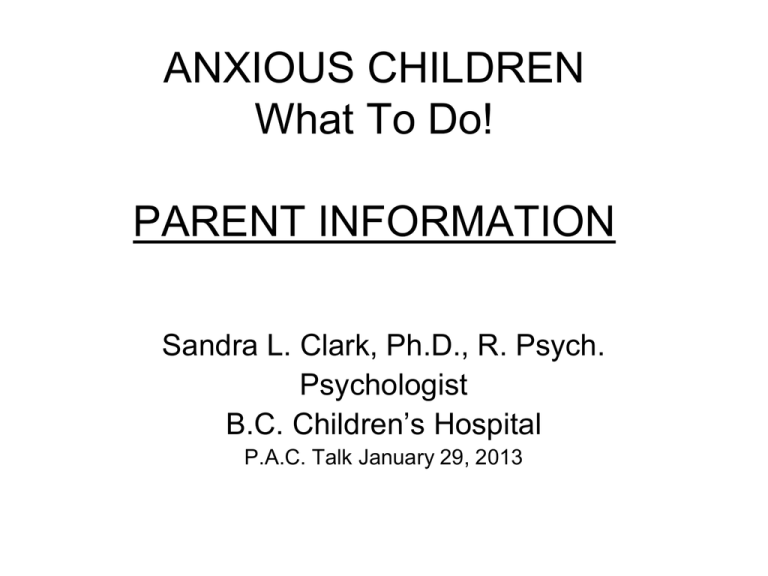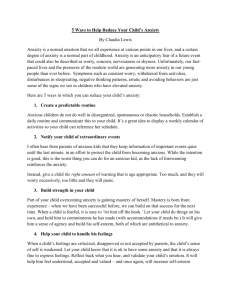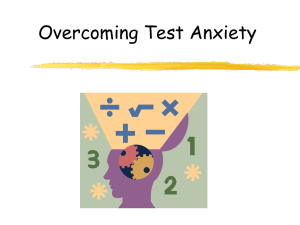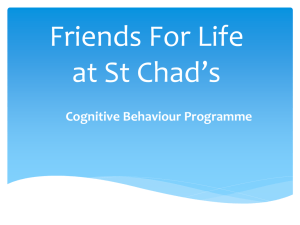Anxious Children Parent Handout
advertisement

ANXIOUS CHILDREN What To Do! PARENT INFORMATION Sandra L. Clark, Ph.D., R. Psych. Psychologist B.C. Children’s Hospital P.A.C. Talk January 29, 2013 About Anxiety • Survival system. • Instinctive way to respond. • It’s Developmental: different anxieties depending on age of child. • Anxiety is physical, psychological, and behavioural. Typical Issues • • • • • • Sleeping problems Refusals and avoidance Physical complaints Irritability Perfectionism and procrastination Pessimism Anxiety Management is a Life Skill • Review your own temperament. • Review your own stress coping style. • Are you modeling effective relaxation, time management and problem-solving? • Consider some family-wide/school-wide strategies: exercise, more sleep, “screens-off” time to relax other ways, tune up the routine, stop to breathe -- and to listen to each other. Helping Anxious Children & Teens • • • • • • • • • • • • • • Know temperament (theirs and yours) Consistent routines Feed often (graze) Exercise & Physical Relaxation Sleep routines Anticipate (transition planning) Promote self-soothing & problem-solving TAKE TIME! Compartmentalizing Distraction Organizational skills Psychological Relaxation/Self-talk Modeling Training self-awareness & self-management TAMING AND TRAPPING WORRY DRAGONS • Imaginative Reconceptualization • Externalizes the Problem • Reframes Anxiety Problems • Allows Child to Talk About Worries • Encourages a Playful, Humorous State of Mind Externalizing Anxiety • Externalizing anxiety by identifying it as separate and naming it. • Child and parent find a name such as “Mr. Worry”, “The Dragon,” “Tricky” or for older children “Angst”, “Worry” or “Freak-out.” • With this comes the identification of the child as the “Tamer”, or “Boss” etc. • The dragon can be seen as trying to trick the child into believing mistruths and creating doubt. Engaging the Reluctant Child: Motivating • Appeal to your child’s pride. E.g. Worriers tend to be bright and imaginative. This has lead to an ability to see the most unexpected dangers. Need to turn this into a talent for taming/trapping the worries. • Make a list with your child about the ways anxiety is interfering with her life. Anxiety causes fear, sadness, crying and fighting. It stops her from participating in school, parties, sleepovers, sports etc. • Then make a positive list of the feelings and things she can do when she is the boss of anxiety. • Be Playful. Relaxation Training • Breathing – Very useful as easy to learn. • Slowly Inhaling through the nose and exhaling through the mouth. • Blowing Bubbles • Make a time to practice each day for at least 2 weeks to become an expert. • Go on to experiment with relaxation and visualization exercises. Helping Children with Self-Talk • Worried thoughts result in increasing anxiety. Calm thoughts bring on a more relaxed mood. • Substitute positive self talk for negative worried thoughts. • Use coping tools: e.g. schedule, thought stopping • Visualize trapping/shrinking/deleting the worry dragon. • Generating alternative thoughts: eg instead of “I can’t do this work”, “I’ll start with an outline…” Building Tolerance • Encouraging Brave Behavior • Need to experience and tolerate anxiety in order to build ‘coping muscles’. • Build a Fear Hierarchy with child and rate according to level of Fear from 1 to 10. • Gradual exposure to feared situations. • Spend at least 20 minutes in challenging situation to bring down anxiety. Facing the Fear • Encourage self reliance with ‘detective thinking’. “What would Sherlock Holmes say about this?” • Gradually withdraw. Let your child know that you will be doing this so they can develop their expertise in detective thinking. • Don’t forget to reward successful self reliance. Rewards for Brave Behavior • Make sure rewards are valued by child • Material rewards-money, food, stickers, & toys. • Non material rewards- praise, attention & interest from parent. Can be very powerful. • Keep rewards varied. • Need to be specific. E.g. ‘David you were able to stay in the room with Susan’s dog for half an hour. That is brave. Well done.’ • Given soon after the child has been brave. • Be in proportion to the level of fear faced. • Establish rewards for other children in family to avoid resentments. Expectations for Change • Go slow, give strategies and tools a fair try – remember that negativity and resistance are natural (at first). • Combinations of strategies will be most effective. • Change should be measured in very, very small increments. • Coping rather than cure model. • Anxiety tends to wax and wane. Summary: Tools & Challenges • Take child’s concerns seriously, while expressing confidence in ability to overcome anxious feelings. Avoid anger. • Gentle encouragement with gradual approach to face worries. • Coping tools take time to learn and require practice and modelling. • Don’t’ forget common sense: food, exercise, sleep, downtime, etc. • Notice and focus on successes and brave behaviour. • Praise is the best reward. RESOURCES • Taming Worry Dragons • Worry Taming for Teens • Keys to Parenting Your Anxious Child. K. Manassis • www.heretohelp.bc.ca • www.anxietybc.com • www.keltymentalhealth.ca











